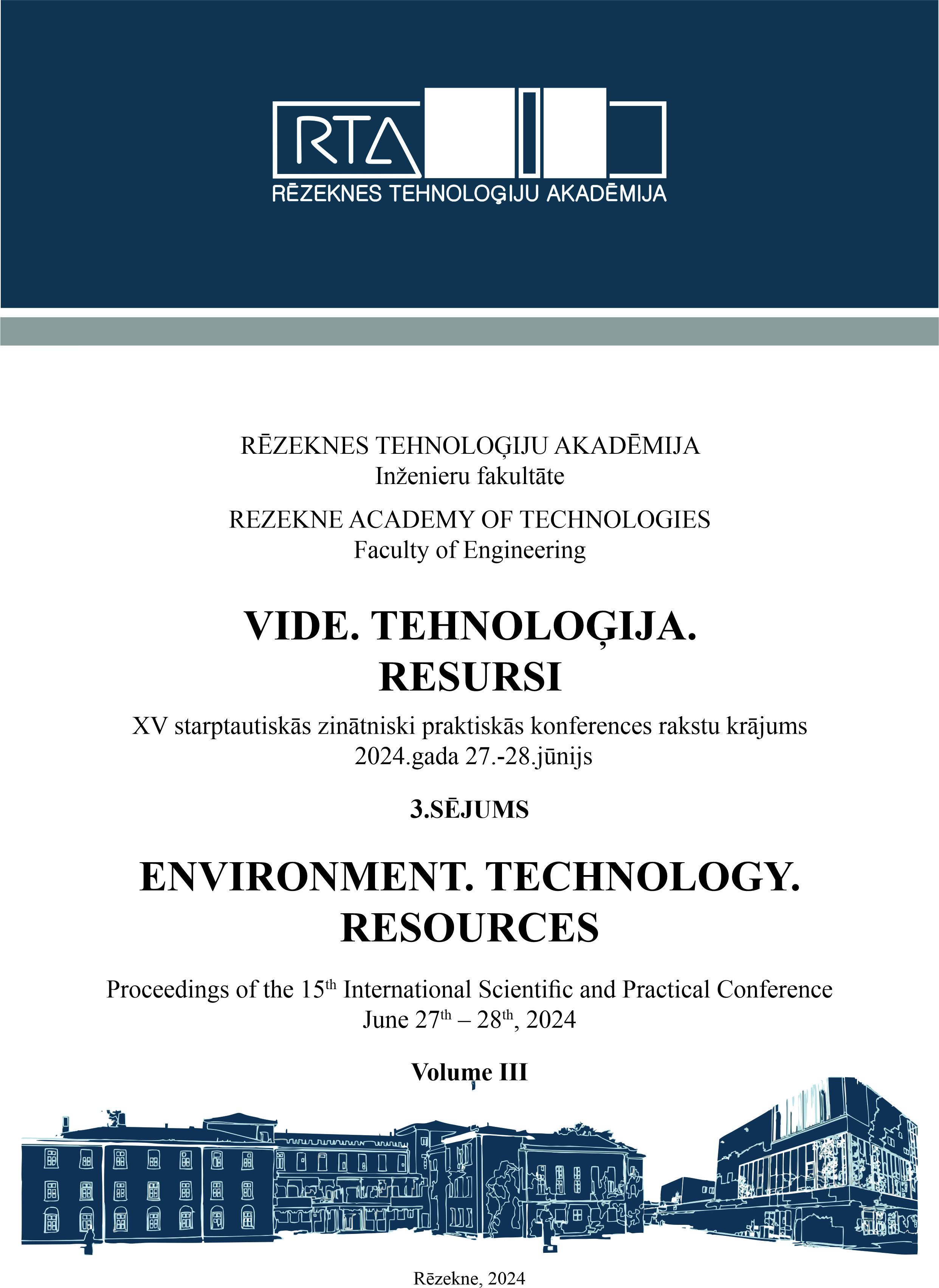DESIGN AND RESEARCH OF A DUAL-BAND IR LENS
DOI:
https://doi.org/10.17770/etr2024vol3.8109Keywords:
MWIR and LWIR spectrum, dual-band IR lens, IR optical materials, optical design, achromatizationAbstract
Infrared imaging systems are widely used in military and civilian applications. Acquiring IR images simultaneously in two spectral ranges provides additional and more detailed information about objects. Dual band IR systems are equipped with a lens that operates simultaneously in two ranges of the IR spectrum MWIR and LWIR. In the design of such a lens, a problem arises with the strong dependence of the refractive index on the wavelength, which requires the correction of chromatic aberration simultaneously in two spectral ranges.
In this article, the possibilities for the synthesis of dual-band lenses in the MWIR and LWIR spectrum using different optical materials are analyzed. The possible combinations of such materials are determined. Dual band lenses are designed using different material combinations. Their optical characteristics are investigated and the possibility of creating relatively simple high-quality dual-band IR lenses is shown.
References
Daniels A. Field Guide to Infrared Systems, Detectors, and FPAs. 2nd ed. – SPIE PRESS, 2007.
Zhang Y.,Liu L., Begum F., Cao G., Zhang J., Yang Y., Zou N., Mid- and long-waveband infrared imaging system design, October 2009, Proceedings of SPIE - The International Society for Optical Engineering, Volume 7494, id. 74940M.
DOI:10.1117/12.833459
Chan L.A., Der S.Z., Nasrabadi N.M. Dual-band FLIR Fusion for Target Detection // Proc. SPIE. – 2002. Vol. 4668. – P. 108-118.
Dual-Band Imaging of Military Targets Using a QWIP Focal Plane Array - Goldberg, T. Fischer and S. Kennerly-EO/IR Technology Branch, Army Research Laboratory, Adelphi, MD 20783 and S. Wang, M. Sundaram, P. Uppal, and M. Winn Advanced Technology Division, Sanders, A Lockheed Martin Company Nashua, NH 03060 - G. Milne and M. Stevens Lockheed-Martin Electronics and Missiles - Orlando, FL.
Rogalski A., Infrared and terahertz detectors, 3rd ed., Boca Raton, CRC Press, 2019.
Catanzaro B.E., Dombrowski M., Hendrixson J., Hillenbrand E., Design of dual-band SWIR/MWIR and MWIR/LWIR imagers, Proc SPIE 2004; 5406, pp. 829-835. DOI: 10.1117/12.543875.
Karimzadeh A., Refractive Dual Band Infrared Imager Optical Design, International Journal of Optics and Photonics, August 2017, 11(2), pp.133-138,
DOI:10.18869/acadpub.ijop.11.2.133
Reibel Y., Chabuel F., Vaz C., Billon-Lanfrey D., Baylet J., Gravrand O., Ballet P., Destefanis G. Infrared Dual Band detectors for next generation // Proc. SPIE. – 2011. – Vol. 8012. – P. 80123B1-1 – P. 80123B1-13.
Greisukh G.I, E.G. Ezhov, I.A. Levin, Designing dual-band athermal refractive-lens IR objectives, Computer Optics 2022; 46(6), pp. 892-898. DOI: 10.18287/2412-6179-CO-1167.
Riedl J.M., Optical Design Fundamentals for Infrared Systems. Second Edition, The Society of Photo-Optical Instrumentation Engineers, SPIE, 2001.
Parfyonova T., Dual-band lens ir lens, Journal " Vestnik SGGA”, Novosibirsk, 2012, 2 (18), pp. 87-93.
Alexay C., Multispectral infrared imaging optics, Proceedings of SPIE, Conference on Infrared Technology and Applications XXIX, April 2003, Vol 5074, pp. 830 - 838. DOI: 10.1117/12.496906.
Romanova G., P. Grzegorz , “Research of aberration properties and passive athermalization of optical systems for infrared region”, in. Proceedings of SPIE, Jena, 2015, Volume 9626, Optical Systems Design: Optical Design and Engineering VI, https://doi.org/10.1117/12.2191119
Garshin A., A. Bakholdin, “Dual-band infrared lenses design”, in. Proceedings of SPIE, Jena, 2015, Volume 9626, Optical Systems Design: Optical Design and Engineering VI, https://doi.org/10.1117/12.2191116
Garshin A., Features of the design of three-lens IR objectives that operate with cooled detectors, Journal of the Optical Society of America B: Optical Physics, Volume 83, Issue 4, pp. 224 - 227, April 2016, DOI: 10.1364/JOT.83.000224.
Tissot JL, Trouilleau C, Fieque B, Crastes A, Legras O., Uncooled microbolometer detector: recent developments at Ulis, Opto-Electron Rev 2006; 14(1), pp.25-32.
DOI: 10.2478/s11772-006-0004-2.
Lazov L, E. Teirumnieks, T. Karadzhov, N. Angelov, Influence of power density and frequency of the process of laser marking of steel products, Infrared Physics & Technology, 2021,Volume 116, 103783,
DOI: 10.1016/j.infrared.2021.103783.
Alaruri, S. D., F/1.6 diffraction-limited air-spaced Cooke triplet photographic lens designs for MWIR and LWIR imaging applications: Geometrical optics performance comparison between Ge-ZnSe-Ge and Si-Ge-Si triplet designs using Zemax, Optik, January 2016, Vol. 127, Issue 1, Pages 254 – 258. DOI: 10.1016/j.ijleo.2015.10.085
Dichev, D., F. Kogia, H. Koev, D. Diakov. Method of Analysis and correction of the Error from Nonlinearity of the Measurement Instruments. Journal of Engineering Science and Technology Review. Volume 9, Issue 6, 2016, pp. 116-121. DOI: 10.25103/jestr.096.17
Iliev G., H. Hristov, Modelling and Simulation of Electropneumatic Positioning System Including the Length of Pneumatic Line, Proceedings of the 14th International Scientific and Practical Conference: Environment. Technology. Resources. Rezekne, Latvia,. Vol. 3, 106-111, 2023, DOI 10.17770/etr2023vol3.7186
Kuo C. W. , Achromatic triplet and athermalized lens assembly for both midwave and longwave infrared spectraq Optical Engineering, 53(2), 021102 February 2014. DOI:10.1117/1.OE.53.2.021102
Kingslake R.R., B. Johnson, Lens Design Fundamentals, SPIE Press, Elsevier Inc, Oxford, UK, 2010.
Downloads
Published
Issue
Section
License
Copyright (c) 2024 Dimcho Pulov

This work is licensed under a Creative Commons Attribution 4.0 International License.



